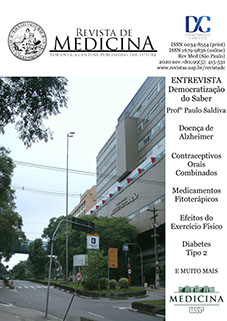Analysis of obstetrical deliveries under conduction anesthesia and immediate neonatal repercussion
DOI:
https://doi.org/10.11606/issn.1679-9836.v99i5p448-455Keywords:
Pregnant women, Hospitals, maternity, Anesthesia, Labor, obstetricAbstract
Introduction: Anesthesia is an important resource for pain relief during labor. It is not a risk-free procedure and its use involves decision-making based on clinical and obstetric conditions, woman’s desire and availability of the procedure. This study aimed to analyze the association between this intervention and the occurrence of operative delivery and low Apgar score. Method: Retrospective study of a hospital database containing 5,282 parturients with single gestation of a fetus with cephalic presentation born alive and without malformation, among the 8,591 births that occurred from 2014 to 2017, in the Clinical Hospital’s Maternity of UFMG. Outcomes of interest were compared between deliveries conducted with or without anesthesia by association tests. Results: The occurrence of labor conduction anesthesia was 29.9%, being more frequent among adolescents (33.3% versus 29.1%; p = 0.008), nulliparous (39.7% versus 21.6%; p<0.001), those with induced delivery (40.6% versus 26.5%; p<0.001), patients with heart disease (53.5% versus 29.6%; p<0.001) and parturients whose babies weighed 2500 g or more at birth (31.3% versus 19.7%; p<0.001). There was an association between anesthesia and increased use of forceps (15.7% versus 1.8%; p<0.001) and vacuum extractor (2.0% versus 0.6%; p<0.001), however, there was a reduction in the occurrence of cesarean section (7.3% versus 12.9%; p<0.001). Anesthesia was associated with a higher occurrence of 1st minute Apgar <7 (p<0.001), but did not change the 5th Apgar score (p = 0.243). Nulliparity seems to influence the occurrence of cesarean delivery (8.6% versus 5.2%; p = 0.013) and forceps use (19.4% versus 9.8%; p<0.001). Conclusion: The use of labor conduction anesthesia was associated with operative vaginal delivery, the lowest cesarean section rate, with no impact on the 5th minute Apgar score.
Downloads
References
Dunn PM. Sir James Young Simpson (1811–1870) and obstetric anaesthesia. Arch Dis Child Fetal Neonatal Ed. 2002;86(3):F207-F209. doi: https://doi.org/10.1136/fn.86.3.F207.
Committee on Practice Bulletins - Obstetrics. Practice Bulletin No. 177: Obstetric Analgesia and Anesthesia. Obstet Gynecol. 2017;129(4):e73-e89. doi: https://doi.org/10.1097/AOG.0000000000002018.
Onuoha OC. Epidural analgesia for labor: continuous infusion versus programmed intermittent bolus. Anesthesiol Clin. 2017;35(1):1-14. doi: https://doi.org/10.1016/j.anclin.2016.09.003.
Fernandes ML, Andrade FCJD. Analgesia de parto: bases anatômicas e fisiológicas. Rev Med Minas Gerais. 2008;19(3 supl.1):S3-S6. Disponível em: http://rmmg.org/exportar-pdf/1228/v19n3s1a02.pdf.
Cunha AA. Analgesia e anestesia no trabalho de parto e parto. Femina. 2010;38(11):599-606. Disponível em: http://files.bvs.br/upload/S/0100-7254/2010/v38n11/a599-606.pdf.
Macendo Amaral HR, Sarmento Filho ED, Matos Silva D, Xavier Gomes LM, de Andrade Barbosa TL. Repercussões maternas e fetais da analgesia obstétrica: uma revisão integrativa. Av Enferm. 2015;33(2):282-94. doi: http://dx.doi.org/10.15446/av.enferm.v33n2.52176.
Brasil. Ministério da Saúde. Gravidez, parto e nascimento com saúde, qualidade de vida e bem-estar. Brasília (DF): Ministério da Saúde; 2013. p.20. Disponível em: https://mesm.uncisal.edu.br/wp-content/uploads/2017/04/GRAVIDEZ-PARTO-E-NASCIMENTO-COM-SA%C3%9ADE.pdf.
Gaspar J, Chagas J, Osanan GC, Cruz-Correa R, Reis ZSN. Maternal and Neonatal Healthcare Information System: Development of an Obstetric Electronic Health Record and Healthcare Indicators Dashboard. In: Bursa M, Khuri S, Renda ME, editors. Information Technology in Bio- and Medical Informatics: 4th International Conference, ITBAM 2013, Prague, Czech Republic, August 28, 2013. Proceedings. Berlin: Springer; 2013. p.62-76. doi: https://doi.org/10.1007/978-3-642-40093-3_5.
Brasil. Ministério da Saúde. Secretaria de Atenção à Saúde. Departamento de Atenção Básica. Atenção ao pré-natal de baixo risco. Brasília (DF); 2012. p.56. (Série A. Normas e Manuais Técnicos Cadernos de Atenção Básica, n° 32). Disponível em: http://bvsms.saude.gov.br/bvs/publicacoes/cadernos_atencao_basica_32_prenatal.pdf.
Aguiar RALPD, et al. Protocolo de condutas da Maternidade Otto Cirne do Hospital das Clínicas da UFMG. Belo Horizonte; 2014.
WHO Study Group on Young People and ‘Health for All by the Year 2000’ & World Health Organization. (1986). Young people’s health - a challenge for society: report of a WHO Study Group on Young People and “Health for All by the Year 2000” [meeting held in Geneva from 4 to 8 June 1984]. World Health Organization. Available from: https://apps.who.int/iris/handle/10665/41720.
Anim-Somuah M, Smyth RM, Cyna AM, Cuthbert A. Epidural versus non-epidural or no analgesia for pain management in labour. Cochrane Database Syst Rev. 2018;5:Cd000331. doi: https://doi.org/10.1002/14651858.CD000331.pub4.
World Health Organization. WHO recommendations: intrapartum care for a positive childbirth experience. Web annex. Evidence base. Geneva; 2018 (WHO/RHR/18.04). Available from: http://apps.who.int/iris/bitstream/handle/10665/260215/WHO-RHR-18.04-eng.pdf;jsessionid=0BE165C34D9E96199E8801A18070177C?sequence=1
Antonakou A, Papoutsis D. The effect of epidural analgesia on the delivery outcome of induced labour: a retrospective case series. Obstetr Gynecol Int. 2016;2016:5. http://dx.doi.org/10.1155/2016/5740534.
Pereira RIC, Cecatti JG, Oliveira ASD. Dor no trabalho de parto: fisiologia e o papel da analgesia peridural. Rev Ciênc Méd (Campinas). 1998;7(3):79-84. http://dx.doi.org/10.1590/S0034-70942007000100005.
França MA, Araujo SA, Abreu EMF, Jorge JC. Anestesia peridural: vantagens e desvantagens na prática anestésica atual. Rev Méd Minas Gerais. 2015;25(S4):S36-S47. doi: https://doi.org/10.5935/2238-3182.20150060.
Yamashita AM, Falcão LFDR. Anestesia para gestante cardiopata. Rev Soc Cardiol Est Sao Paulo. 2010;20(4):469-80. ID: lil-574398 19(4 Supl 1):S21-S62
Regitz-Zagrosek V, Roos-Hesselink JW, Bauersachs J, et al. 2018 ESC Guidelines for the management of cardiovascular diseases during pregnancy: the task force for the management of cardiovascular diseases during pregnancy of the European Society of Cardiology (ESC). Eur Heart J. 2018;39(34):3165-241. doi: https://doi.org/10.1093/eurheartj/ehy340.
Brasil. Ministério da Saúde. Diretrizes nacionais de assistência ao parto normal. Brasília; 2017. p.53. Disponível em: http://bvsms.saude.gov.br/bvs/publicacoes/diretrizes_nacionais_assistencia_parto_normal.pdf.
Brasil. Ministério da Saúde. Secretaria de Atenção à Saúde. Departamento de Ações Programáticas. Gestação de alto risco: manual técnico. Série A Normas e Manuais Técnicos. Brasília; 2012. p.301. Disponível em: http://bvsms.saude.gov.br/bvs/publicacoes/manual_tecnico_gestacao_alto_risco.pdf.
Guerra GV, Cecatti JG, Souza JP, et al. Elective induction versus spontaneous labour in Latin America. Bull World Health Organ. 2011;89(9):657-65. doi: https://doi.org/ 10.2471/BLT.08.061226.
Bittar RE. Parto pré-termo. Rev Med (São Paulo). 2018;97(2):195-207. doi: https://doi.org/10.11606/issn.1679-9836.v97i2p195-207.
Johanson R, Menon V. WITHDRAWN: Vacuum extraction versus forceps for assisted vaginal delivery. Cochrane Database Syst Rev. 2010(11):CD000224. doi: https://doi.org/ 10.1002/14651858.CD000224.
Downloads
Published
Issue
Section
License
Copyright (c) 2020 Gabriela Ribeiro Gontijo, Marilene Miranda Araújo, Zilma Silveira Nogueira Reis

This work is licensed under a Creative Commons Attribution-ShareAlike 4.0 International License.




